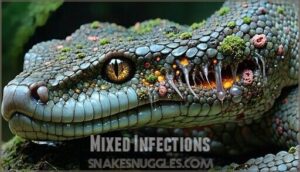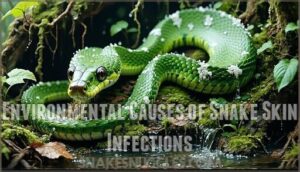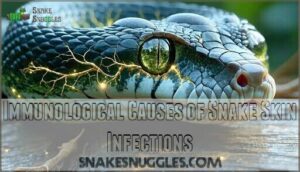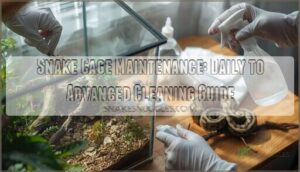This site is supported by our readers. We may earn a commission, at no cost to you, if you purchase through links.
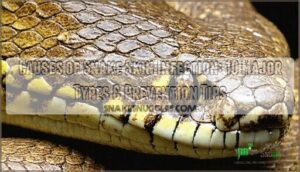 The causes of snake skin infection range from bacterial invaders like Pseudomonas and Aeromonas to fungal threats such as Snake Fungal Disease, which can kill up to 90% of affected snakes.
The causes of snake skin infection range from bacterial invaders like Pseudomonas and Aeromonas to fungal threats such as Snake Fungal Disease, which can kill up to 90% of affected snakes.
You’ll also find parasites, poor nutrition, environmental problems like wrong temperatures, and even stress weakening your snake’s defenses.
Bacterial infections often lead to painful dermatitis and life-threatening septicemia, while fungal diseases cause facial swelling and abnormal shedding patterns.
External parasites create open wounds, and internal ones compromise immunity, which can lead to serious health issues if not addressed promptly, highlighting the importance of understanding these ten major categories to spot trouble early.
Understanding these categories helps you take action before minor issues become serious health crises.
Table Of Contents
- Key Takeaways
- Bacterial Causes of Snake Skin Infections
- Fungal Causes of Snake Skin Infections
- Parasitic Causes of Snake Skin Infections
- Viral Causes of Snake Skin Infections
- Nutritional Causes of Snake Skin Infections
- Environmental Causes of Snake Skin Infections
- Traumatic Causes of Snake Skin Infections
- Immunological Causes of Snake Skin Infections
- Systemic Causes of Snake Skin Infections
- Emerging Threats to Snake Skin Health
- Frequently Asked Questions (FAQs)
- How do Snakes get fungus?
- What happens if a snake gets fungus?
- What is snake fungal disease?
- What causes discolored skin in snakes?
- What is snake fungal disease (SFD)?
- How do you know if a snake is infected?
- How to treat snake skin infection?
- What causes snake infections?
- What is the cause of snake skin?
- Why do people get snake skin?
- Conclusion
Key Takeaways
- You’ll face multiple infection sources including bacterial invaders like Pseudomonas, fungal threats such as Snake Fungal Disease, parasites, and environmental problems that can kill up to 90% of affected snakes if left untreated.
- Poor husbandry creates the perfect storm for infections – you need to maintain proper temperature, humidity, cleanliness, and nutrition while avoiding rough substrates and ensuring adequate ventilation in your snake’s enclosure.
- Your snake’s weakened immune system from stress, malnutrition, or genetic factors makes it vulnerable to opportunistic infections, so you must provide consistent care and monitor for early warning signs like facial swelling or crusty lesions.
- Mixed infections are common (affecting 81.5% of cases), making treatment complex – you’ll need immediate veterinary attention for proper diagnosis through bacterial cultures, PCR testing, or skin biopsies to identify specific pathogens and prevent life-threatening septicemia.
Bacterial Causes of Snake Skin Infections
Bacterial infections rank among the most common culprits behind snake skin problems, with gram-negative bacteria like Pseudomonas and Aeromonas leading the charge in creating painful dermatitis that can quickly spiral into life-threatening septicemia.
These microscopic villains turn minor irritation into deadly septicemia faster than you’d expect.
When these tiny parasites invade, healthy skin becomes infected tissue overnight
You’ll often encounter these sneaky pathogens taking advantage of stressed, malnourished, or poorly housed snakes, turning minor skin irritation into serious health crises that require immediate veterinary attention.
Gram-Negative Bacteria
Gram-negative bacteria like Pseudomonas and Aeromonas are sneaky culprits behind snake skin infections.
These troublemakers pack a punch with antibiotic resistance, making treatment tricky.
Here’s what makes them dangerous:
- Antibiotic resistance: They laugh at standard treatments
- Septicemia risk: Infections spread fast through bloodstream
- Diagnostic challenges: Gram-staining and bacterial culture with sensitivity testing required
If left untreated, it can lead to septic shock in snakes.
Mixed Infections
Mixed infections create a perfect storm in your snake’s skin.
These bacterial-fungal mix scenarios affect roughly 81.5% of all skin infections, making treatment trickier than single-pathogen cases.
You’ll often find secondary infections piggybacking on primary issues, especially when your snake’s stressed or immunocompromised.
Environmental factors fuel this pathogen party.
Snakes are also vulnerable to opportunistic fungal pathogens like Mucor, especially if immunocompromised.
Transmission to Humans
Cross-contamination risk exists when handling infected snakes. Zoonotic potential means bacteria can jump from snakes to humans through direct contact with wounds or contaminated surfaces.
Here’s how to protect yourself:
- Wear gloves during handling and cleaning enclosures
- Wash hands thoroughly with antibacterial soap after snake contact
- Disinfect equipment and surfaces using appropriate sanitizers
- Avoid touching your face while working with reptiles
- Seek medical attention if you develop skin irritation after handling
Risk groups include veterinarians and reptile keepers who need extra hygiene practices awareness for public health protection.
Fungal Causes of Snake Skin Infections
Fungal infections in snakes can be sneaky troublemakers that often catch owners off guard.
Snake Fungal Disease, caused by the persistent Ophidiomyces ophiodiicola fungus, creates crusty lesions and facial swelling that can seriously harm your pet’s health.
Snake Fungal Disease (SFD)
Snake Fungal Disease (SFD) threatens your snake’s health like an unwelcome houseguest that won’t leave.
This sneaky snake fungal infection affects over 42 species across three continents.
SFD transmission occurs through contact with infected animals or contaminated environments.
You’ll notice facial swelling, crusty lesions, and abnormal molting patterns.
SFD diagnosis requires laboratory testing, while SFD treatment involves antifungal medications.
The SFD impact on populations can be devastating, with mortality rates reaching 90% in some species.
Proper SFD prevention starts with good hygiene practices.
Ophidiomyces Ophiodiicola Fungus
Ophidiomyces ophiodiicola stands as the confirmed villain behind most snake fungal infections.
This environmental fungus shows surprising species susceptibility patterns, hitting some snakes harder than others.
Diagnostic methods now rely on PCR testing and tissue samples for accuracy.
Environmental spread occurs through contaminated soil and water sources.
While SFD treatment remains challenging, identifying emerging strains helps researchers stay ahead of this persistent threat.
Clinical Signs of SFD
Facial swelling and crusty lesions are telltale signs you’re dealing with snake fungal disease SFD.
You’ll spot thickened scales, facial deformities, and scale disfigurement that look crusty or raised.
Watch for behavioral changes like lethargy, reduced appetite, or difficulty shedding.
Dermatitis signs often start small but spread quickly, creating a patchwork of damaged skin that screams "get help now!
Parasitic Causes of Snake Skin Infections
Parasites pose a serious threat to your snake’s skin health, with tiny mites and ticks acting like unwelcome house guests that never leave.
These pesky creatures don’t just irritate your pet’s skin – they create open wounds and weaken immunity, setting the stage for dangerous secondary infections that can quickly spiral out of control, leading to a significant impact on your snake’s overall health and potentially causing serious harm.
External Parasites
External parasites are like unwelcome houseguests that won’t leave your snake alone. Mite Infestations and Tick Exposure cause relentless irritation, leading to Scale Damage through constant scratching and feeding.
These snake skin parasites create open wounds, making secondary parasitic infections likely.
Here’s what you’ll encounter:
- Mites – tiny blood-suckers causing severe discomfort
- Ticks – larger parasites creating localized swelling
- Nematodes – microscopic worms affecting skin integrity
Vector Transmission spreads diseases between snakes, while parasite infestation weakens immune systems.
Fortunately, Treatment Options include specialized sprays and environmental cleaning.
Internal Parasites
Internal parasites pose a hidden threat that can manifest as serious snake skin infections.
These microscopic troublemakers — including nematodes, protozoans, and other internal parasites — compromise your snake’s immune system, making skin vulnerable to secondary infections.
Common internal parasites include:
- Nematodes (roundworms)
- Trematodes (flukes)
- Protozoan parasites (single-celled organisms)
Parasite life cycles often involve tissue migration, creating entry points for bacterial infections.
Diagnostic techniques like fecal exams help identify these culprits early.
Deworming medications target specific parasites, while preventative measures include quarantine protocols and regular health screenings to protect against zoonotic potential and parasitic infections.
- Nearly half of pet snakes harbor internal parasites — making regular screening your snake’s best defense against devastating skin complications.
Viral Causes of Snake Skin Infections
Viruses can sneak into your snake’s system and cause skin problems that’ll make you scratch your head wondering what went wrong.
While less common than bacterial or fungal infections, viral skin issues in snakes are real troublemakers that need your attention.
Adenoviruses
Adenoviruses pack a punch when they target your snake’s skin through adenovirus transmission.
These DNA viruses cause swelling, lesions, and breathing issues. Adenovirus symptoms include skin discoloration and lethargy.
Adenovirus diagnosis requires lab testing, while adenovirus treatment focuses on supportive care. Advanced imaging techniques aid in diagnosis.
Adenovirus prevention means maintaining clean habitats and quarantining new arrivals.
Other Viral Skin Infections
Beyond adenoviruses, several viral infections can damage your snake’s skin.
Herpesvirus infections cause ulcerative lesions and papillomas, while iridovirus infections create pox-like spots and scale loss.
Paramyxovirus triggers necrotizing viral dermatitis.
Viral transmission often occurs through contaminated feeders or direct contact.
Accurate diagnosis requires skin biopsy and PCR testing.
Strong prevention strategies include quarantine protocols and proper hygiene practices.
Nutritional Causes of Snake Skin Infections
You’d be surprised how much your snake’s diet affects their skin health – poor nutrition weakens their immune system and makes them vulnerable to infections.
A balanced diet with proper calcium, vitamin D3, and essential nutrients acts like armor against skin problems, while deficiencies leave your scaly friend defenseless against bacteria and fungi, highlighting the importance of a balanced diet for overall health and immune system.
Deficiencies in Calcium and Vitamin D3
When your snake’s calcium and vitamin D3 levels drop, shedding problems and weakened bone health follow close behind.
Without proper UV lighting or dietary supplementation, calcium absorption suffers, creating nutritional deficiencies that compromise skin integrity.
These missing vitamins and minerals don’t just affect bones—they directly impact your snake’s ability to shed properly and fight off skin infections.
Poor Nutrition and Skin Health
Poor nutrition creates a domino effect on your snake’s skin health.
When your pet isn’t getting proper nutrients, their immune system weakens, making them vulnerable to infections.
Malnourished and immunosuppressed snakes can’t fight off bacteria and fungi effectively.
Here’s how nutritional deficiencies impact skin health:
- Malnutrition effects include slower wound healing and increased infection risk
- Dietary deficiencies cause brittle, damaged scales that crack easily
- Nutrient imbalance leads to poor hydration and dry, flaky skin
- Skin lesions develop more frequently in poorly nourished snakes, resulting in poor skin health and increased infection risk due to malnutrition.
Importance of Balanced Diet
Think of your snake’s diet like building blocks—each Essential Nutrients piece matters for Immune Support and Healthy Shedding.
Nutritional deficiencies create weak spots where infections sneak in.
A balanced diet with proper vitamins and minerals provides Preventative Care that keeps skin strong.
| Nutrient Type | Food Sources | Skin Benefits |
|---|---|---|
| Protein | Mice, rats, chicks | Tissue repair, shedding |
| Calcium | Whole prey bones | Scale strength, healing |
| Vitamins A/D3 | Liver, supplements | Cell regeneration, immunity |
Your nutritional support strategy directly impacts Diet Impact on overall health—no shortcuts here!
Environmental Causes of Snake Skin Infections
Your snake’s environment can make or break their skin health, and getting it wrong often leads to painful infections.
Poor husbandry creates the perfect storm for bacteria and fungi to thrive, turning a cozy home into a breeding ground for disease.
Temperature and Humidity Imbalances
Temperature extremes wreak havoc on your snake’s delicate skin barrier.
When humidity levels drop too low or soar too high, you’re setting the stage for serious health issues that’ll have you scrambling for solutions.
- Shedding problems emerge when snake improper humidity creates sticky, incomplete molts
- Scale rot develops in overly moist environments with poor ventilation issues
- Thermal burns occur from unregulated heating elements in your snake environment
Maintaining proper living conditions means consistent temperature and humidity monitoring.
You may need a reliable humidity controller to guarantee the best conditions.
Skin Irritation From Substrate or Decorations
Your substrate choices directly impact your snake’s skin health. Rough substrates cause substrate abrasions, while some decorations pose decoration toxicity risks from chemicals or sharp edges.
| Risk Factor | Common Sources | Prevention Tips |
|---|---|---|
| Abrasive surfaces | Sand, gravel, rough wood | Choose smooth cypress mulch or paper |
| Impaction risks | Loose particles, small stones | Avoid sand; use larger substrate pieces |
| Allergenic materials | Cedar, pine shavings | Select aspen or newspaper instead |
| Chemical exposure | Painted decorations, treated wood | Use reptile-safe, untreated materials only |
Maintain enclosure hygiene by cleaning substrate weekly and inspecting decorations for damage that could harm your snake’s delicate skin. Selecting the right materials can involve finding a suitable reptile bedding for your snake.
Poor Ventilation and Air Quality
Your snake’s enclosure needs proper airflow like you need fresh air to breathe.
Stagnant air creates a breeding ground for toxin buildup, leading to respiratory problems and shedding issues.
Poor ventilation affects temperature and humidity control, creating snake unsanitary conditions.
Enclosure size matters too – cramped spaces worsen air quality.
Think of it like living in a stuffy closet versus a well-ventilated room.
Your snake environment requires adequate ventilation to prevent infections.
Proper snake habitat hygiene includes ensuring fresh air circulation to keep your serpent healthy and comfortable.
Traumatic Causes of Snake Skin Infections
Physical injuries break your snake’s protective skin barrier, creating perfect entry points for bacteria and fungi.
These traumatic wounds—from rough substrate, handling mishaps, or encounters with cage mates—quickly turn into serious infections if not treated promptly.
Abrasions and Lacerations
In regards to snake skin trauma, abrasions and lacerations create open doors for infection.
These wounds compromise your snake’s natural barrier, allowing bacteria to invade damaged tissue.
Proper wound management becomes essential for preventing snake skin infection.
Here’s what increases risk:
- Rough substrate materials causing constant scale damage
- Sharp enclosure hazards like broken decorations or wire mesh
- Improper handling leading to traumatic injuries
- Poor healing process due to inadequate wound care
- Delayed treatment allowing snake wound infection to develop
To facilitate recovery, consider specialized snake products.
Bites and Injuries From Other Animals
Beyond scrapes and cuts, predator bites from other animals create serious snake wound infection risks.
Rodent injuries and attacks from enclosure mates introduce bacteria directly into tissue. Bite complications include polymicrobial infections requiring immediate wound management.
Focus on bite prevention through proper housing and supervision to avoid traumatic injuries that compromise wound healing.
| Injury Type | Common Bacteria | Treatment Priority |
|---|---|---|
| Predator Bites | Aeromonas, Pseudomonas | Immediate cleaning |
| Rodent Injuries | Staphylococcus spp. | Antibiotic therapy |
| Enclosure Mate Wounds | Mixed polymicrobial | Surgical debridement |
Skin Infections From Traumatic Events
Every wound becomes a doorway for bacteria when your snake faces traumatic skin infections from various enclosure hazards.
Bite Wounds, Burn Injuries, and Handling Trauma create openings where harmful pathogens invade, causing painful infections that can spread systemically if left untreated.
Here’s how traumatic skin infections develop:
- Bite complications from cage mates or prey animals tear protective skin barriers
- Burn infections occur when heating elements cause thermal damage and tissue death
- Enclosure trauma from sharp decorations creates abrasions that harbor bacteria
- Shedding Issues worsen when wounds interfere with normal skin renewal processes
Proper wound care prevents these serious complications.
Immunological Causes of Snake Skin Infections
Your snake’s immune system acts as its first line of defense against skin infections, but when it’s compromised, bacteria and fungi can easily take hold.
Stress, poor nutrition, and genetic factors can weaken your pet’s natural defenses, making even minor skin issues turn into serious problems.
Your pet’s natural defenses are crucial in preventing skin infections from becoming severe.
Immunodeficiency and Skin Infections
When your snake’s immune system weakens, it’s like leaving the front door unlatched—opportunistic infections waltz right in.
Stress and immunity work hand-in-hand; poor husbandry impact creates chronic stress, suppressing natural defenses against bacterial infections and fungal infections.
Snake immune deficiency from overcrowding, temperature fluctuations, or malnutrition makes your pet vulnerable to snake skin infections.
Focus on immune support through proper nutrition, stable environments, and stress reduction to keep those pesky pathogens at bay.
Immunosuppression can also lead to secondary skin infections.
Genetic Predispositions to Skin Infections
Your snake’s genetic mutations might make them sitting ducks for snake skin disorders.
Some reptiles inherit faulty Gene Expression patterns affecting their immune system, creating weak spots in Disease Resistance.
Think of it like getting your grandmother’s china—beautiful but fragile.
Inherited Immunity defects and hereditary factors can trigger snake immune deficiency, making infections inevitable despite perfect care.
Autoimmune Disorders and Skin Health
While genetic factors set the stage, autoimmune impact can turn your snake’s immune system against itself.
When immune dysregulation occurs, the body attacks healthy skin cells, creating snake skin inflammation and painful skin lesions.
Here’s what happens during autoimmune flare-ups:
- Inflammatory responses damage normal skin tissue
- Self-attacking antibodies target healthy cells
- Chronic snake skin lesions develop from ongoing inflammation
Treatment options focus on immune suppression and supportive care. Stress reduction helps prevent genetic factors from triggering these misdirected immune attacks that cause snake skin infection.
Systemic Causes of Snake Skin Infections
Your snake’s internal health directly affects its skin condition, and systemic problems can trigger serious infections you’ll need to address quickly.
When your snake’s heart, digestive system, or hormones aren’t working properly, its skin becomes vulnerable to bacteria and fungi that normally wouldn’t cause trouble.
Heart and Blood Vessel Disorders
Your snake’s heart and circulation problems can trigger serious skin infections.
When blood pressure drops or cardiovascular issues develop, your pet’s immune system weakens dramatically.
Poor circulation reduces oxygen delivery to skin tissues, creating perfect conditions for bacterial infections and fungal infections.
Genetic factors may predispose certain species to cardiac issues.
Proper snake veterinary care includes monitoring cardiovascular health, as heart problems often precede dangerous snake skin infection outbreaks.
Recognizing these issues early can prevent systemic disease progression.
Digestive Disorders and Skin Health
Your snake’s Gut Microbiome can throw a wrench into skin health when digestive troubles strike.
Poor Diet Impact leads to Malabsorption Effects, creating nutritional support gaps that weaken your pet’s Immune Response.
- Gut Microbiome disruption compromises natural defenses
- Malabsorption Effects prevent proper nutrition uptake
- Toxin Buildup occurs when digestion fails
- Vitamin A deficiency leaves malnourished snakes vulnerable to infections
Hormonal Imbalances and Skin Infections
When hormones go haywire, your snake’s skin suffers.
Thyroid function disruptions affect shedding problems, while elevated cortisol impact from stress weakens the immune system.
Estrogen levels can alter skin coloration and integrity.
These imbalances create perfect conditions for bacterial infections and fungal infections.
Immune suppression from hormonal chaos makes snake skin infection more likely.
Proper nutritional support helps stabilize hormones naturally.
Emerging Threats to Snake Skin Health
You’re now facing new and evolving threats that weren’t on researchers’ radars just a decade ago.
These emerging pathogens can spread quickly through wild populations and captive collections, making early detection your best defense against potential outbreaks.
Snake Fungal Disease Research and Prevention
Combating snake fungal disease starts with understanding this devastating threat.
Researchers are racing against time to develop better SFD diagnostics and tackle antifungal resistance before it spreads further through environmental reservoirs.
The disease is caused by the Ophidiomyces ophiodiicola fungus, impacting numerous snake species.
- Implement preventative husbandry protocols to protect your snake from Ophidiomyces ophiodiicola exposure
- Support conservation impacts research that helps wild snake populations survive fungal infections
- Monitor environmental modifications in your snake’s habitat to prevent fungal growth
- Report suspected cases immediately to help scientists track snake fungal infection patterns
Other Emerging Skin Infections in Snakes
Battleground bacteria are shifting the rules of engagement.
Novel Pathogens like **Nannizziopsis spp.
challenge traditional treatments, while Antibiotic Resistance** complicates bacterial infections.
Climate Change and Global Trade spread these threats faster than ever.
| Emerging Threat | Primary Challenge | Impact on Snakes |
|---|---|---|
| Novel Pathogens | Diagnostic Challenges | Delayed treatment |
| Antibiotic Resistance | Treatment failure | Systemic infection |
| Climate factors | Stress vulnerability | Immunosuppressed hosts |
| Global spread | Rapid transmission | Population decline |
You’ll need specialized veterinary care for these emerging pathogens targeting immunosuppressed snakes through bacterial fungal parasitic infections.
Importance of Monitoring and Reporting
You’re the first line of defense against snake skin infections.
Early detection through regular veterinary checkups and monitoring early warning signs helps improve treatment efficacy and prevents disease spread.
Your observations contribute to data collection that builds public awareness about emerging threats.
Document any unusual skin infection diagnosis findings and report them to wildlife authorities or researchers—your vigilance helps protect snake populations everywhere.
Frequently Asked Questions (FAQs)
How do Snakes get fungus?
Snakes get fungus when they’re exposed to contaminated environments with poor hygiene, improper humidity levels, or stress.
The fungus Ophidiomyces ophiodiicola thrives in dirty conditions and enters through damaged skin or wounds.
What happens if a snake gets fungus?
If your snake gets fungus, you’ll see crusty lesions and facial swelling that can cause severe disfigurement.
Snake Fungal Disease weakens their immune system, making recovery challenging without proper antifungal treatment.
What is snake fungal disease?
Like a shadow creeping through your pet’s world, Snake Fungal Disease strikes when you’d least expect it.
You’ll recognize this nasty infection by its crusty lesions and facial swelling – it’s caused by Ophidiomyces ophiodiicola fungus.
What causes discolored skin in snakes?
Bacterial infections, fungal diseases, or parasitic infestations typically cause your snake’s skin to change color.
You’ll notice redness from bacteria, crusty patches from fungi, or irritation from mites affecting normal pigmentation.
What is snake fungal disease (SFD)?
Imagine your pet python’s beautiful scales turning crusty and disfigured—that’s Snake Fungal Disease wreaking havoc.
SFD’s caused by Ophidiomyces ophiodiicola, an environmental fungus that creates facial swelling and severe skin lesions, primarily affecting eastern United States snakes, which is a result of Ophidiomyces ophiodiicola.
How do you know if a snake is infected?
You’ll spot warning signs like skin discoloration, crusty lesions, swelling, or unusual shedding patterns.
Watch for behavioral changes too—infected snakes often become lethargic, lose weight, or show breathing difficulties that signal trouble.
How to treat snake skin infection?
Healing your snake’s infected skin is like being a battlefield medic—you’ll need antibiotics, antifungals, or antiparasitic medications depending on the infection type.
Clean wounds with antiseptic solutions, improve enclosure hygiene, and maintain proper humidity levels for recovery.
What causes snake infections?
Poor husbandry creates the perfect storm for snake infections.
You’ll see problems when enclosures stay too humid, substrates get dirty, temperatures run wrong, or your snake faces stress, trauma, or poor nutrition, which can be considered as poor husbandry.
What is the cause of snake skin?
Like a fortress needs strong walls, your snake’s skin forms its first defense barrier.
You’ll find snake skin develops from specialized cells called keratinocytes that create protective scales through continuous growth and shedding cycles, which is a key process in the development of a snake’s defense.
Why do people get snake skin?
You’ll develop "snake skin" (xerosis cutis) when your skin loses moisture and natural oils, causing it to become dry, scaly, and flaky with a rough texture resembling snake scales.
Conclusion
Protecting your snake from skin problems isn’t rocket science, but it does require attention to detail.
While wild snakes battle nature’s challenges, captive reptiles face different risks in their controlled environments.
Understanding the causes of snake skin infection helps you spot warning signs before they become serious health emergencies.
You’ll prevent most issues by maintaining proper humidity, temperature, and cleanliness while providing quality nutrition and veterinary care when needed, which is crucial for preventing serious health emergencies.
- https://www.vetlexicon.com/exotis/reptiles/dermatology/articles/bacterial-dermatitis/
- https://www.merckvetmanual.com/exotic-and-laboratory-animals/reptiles/bacterial-diseases-of-reptiles
- https://www.nature.com/articles/s41598-018-30709-x
- https://pmc.ncbi.nlm.nih.gov/articles/PMC4345101/
- https://laboklin.com/en/infectious-dermatoses-in-reptiles/


